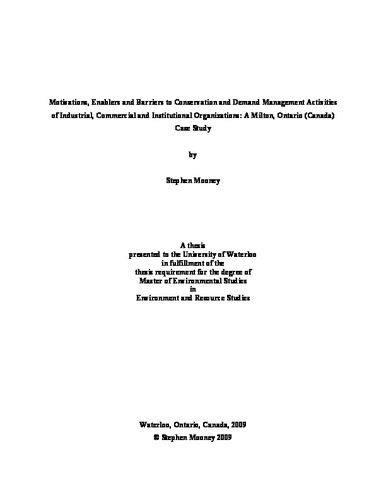| dc.description.abstract | In 2009, Ontario’s electricity system is in the midst of redevelopment to be sustainable, competitive and reliable. To advance this goal, conservation and demand management (CDM) is a key part of the plan. For CDM plans to be successful, it is necessary to understand why organizations undertake CDM activities. This thesis presents a case study, from 2001 to 2006, investigating organizations’ motivations, enablers and barriers associated with conservation, efficiency and demand response activities. Participants included general service customers with loads greater than 50 kW in Milton, Ontario (Canada). Interviews with representatives from 17 organizations included industrial, commercial and institutional customers. Observations at Milton Hydro Energy Drill Program events, analyses of participants’ electricity usage data, and investigations of the participants’ public profiles were included in the case study. All participants reported undertaking at least one CDM activity. The primary motivation was financial benefit. Customer satisfaction was also an important motivator for some participants. Adhering to business policies and objectives and environmental benefit were complimentary to these main motivations. The Energy Drill Program, in some cases, led to increased conservation and efficiency by encouraging a focus on internal systems and practices as well as by providing an opportunity for businesses to save on operating costs while benefiting from an associated positive public image. The commercial and industrial participants were interested in CDM activities as long as they fit within their business financial management requirements and/or contributed to their business’s competitiveness through improved image or otherwise. The social and/or environmental benefits were seen as complimentary, yet not enough to drive the activities on their own. Most of the institutional participants emphasized the community contribution as an enabler of their participation in the demand response program, however, two of the four such participants did not appear to participate in the program on a regular basis, based on the program impact reports. This incongruity between reported and actual behaviour in this sector may be an interesting area for further research. The barriers reported were for known opportunities and these included the inadequate and uncertain financial benefits, technological uncertainty, and, particularly for the small to medium sized businesses, the limited capacity to further investigate and pursue opportunities. Future research could investigate each sector and/or CDM activity sub-category independently for more specific insights. | en |

